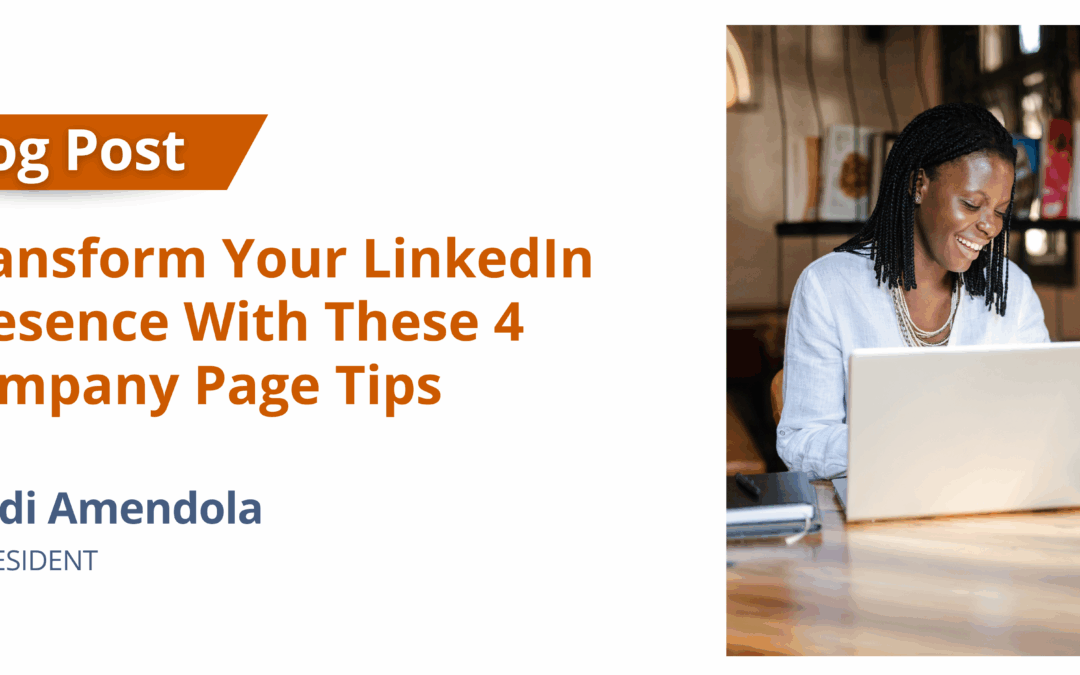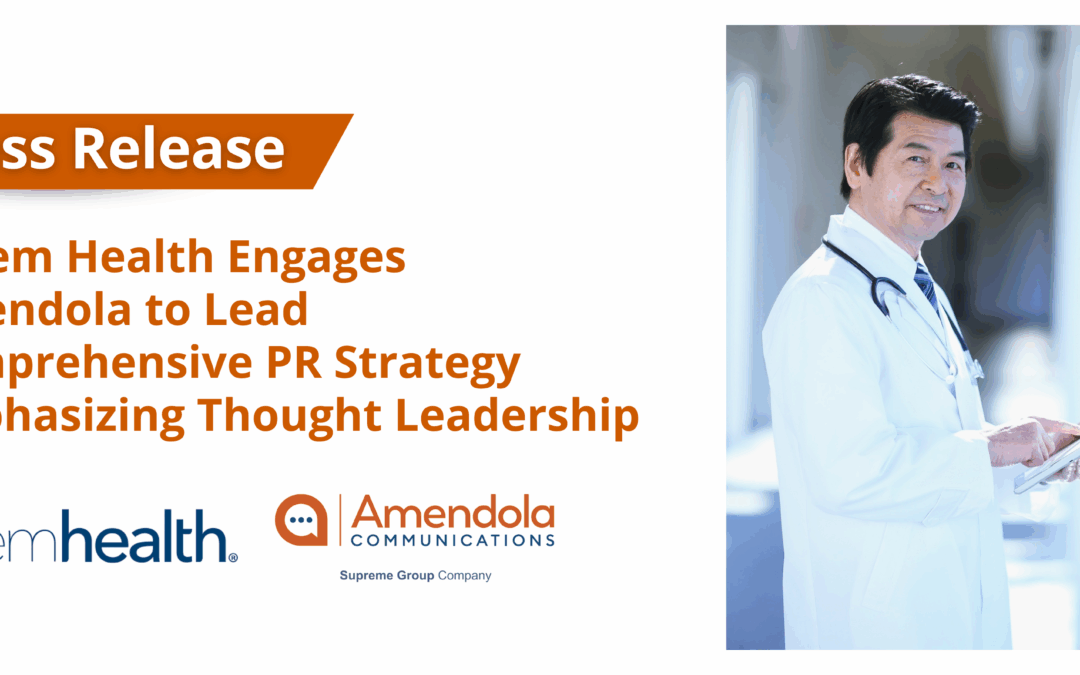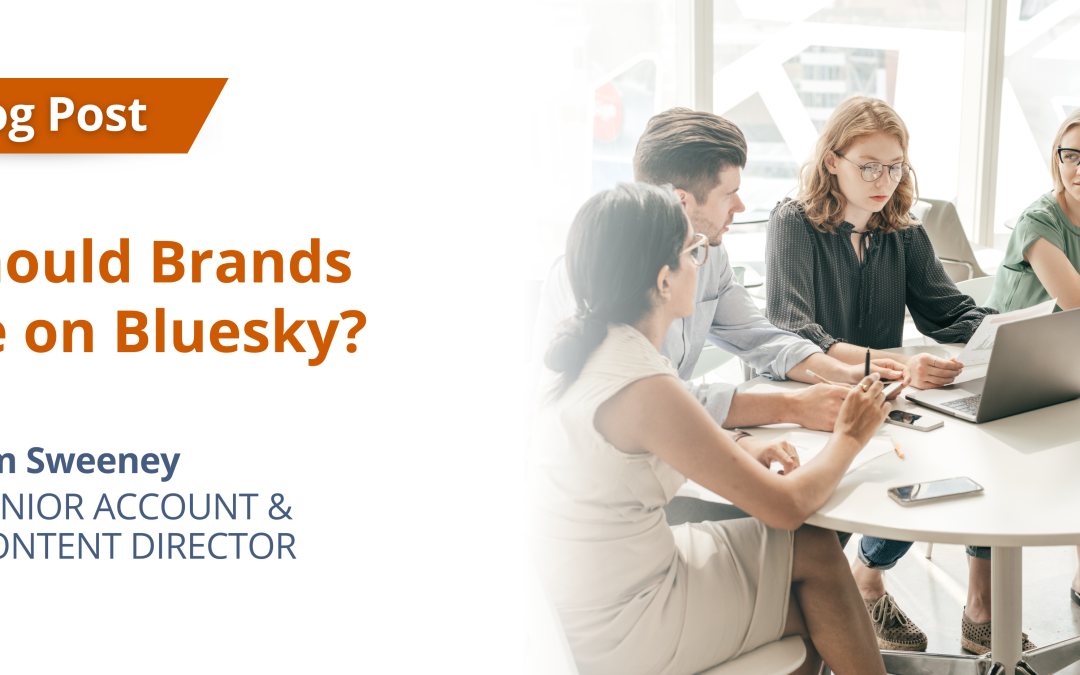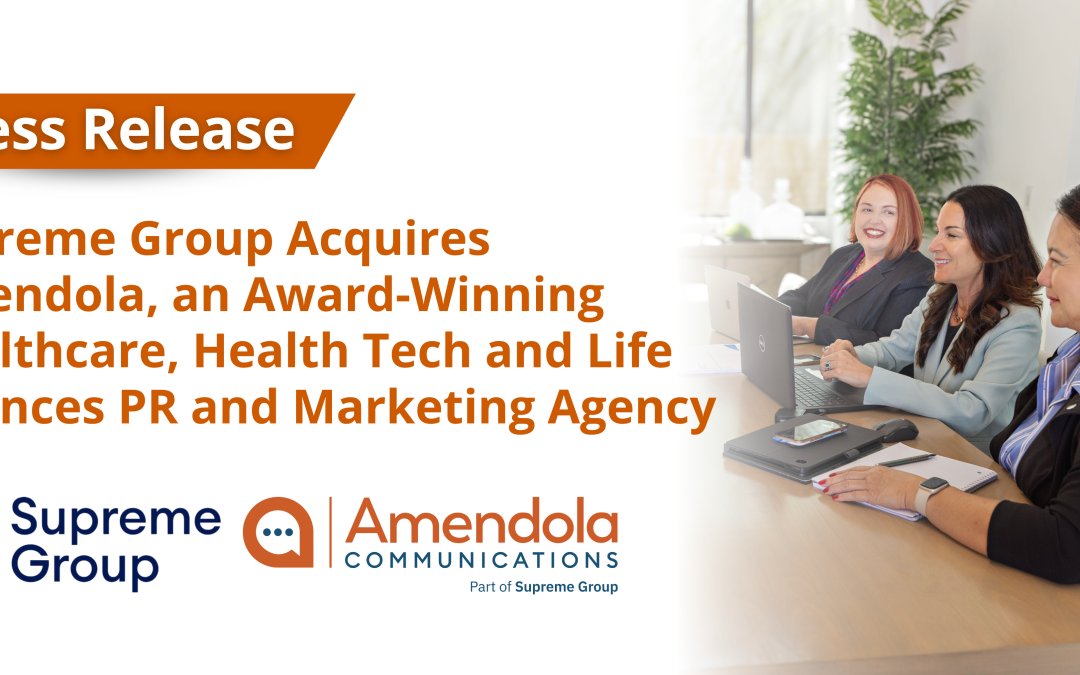
by Jodi Amendola | Dec 3, 2025 | Blog
For companies and business professionals seeking to see and be seen, LinkedIn is the place to be.
The social platform has reached a count of 1.2 billion members across 200 countries and regions, with more than 243 million in the U.S. Somewhat surprisingly, more members hail from Europe and the Asia-Pacific region than North America.
Every minute on LinkedIn, more than 9,500 members apply for jobs, 17,000 connections are made, and 148 hours of learning content is consumed, according to the company.
While most professionals today have created and are maintaining our personal profiles with job-related news and accomplishments, marketing and communications workers may also be asked to take on the responsibility of managing company pages.
Company pages are very similar to personal pages in that page owners share relevant news and updates, connect with other people and companies, and enhance brand awareness. A well-managed company page can offer numerous benefits, helping organizations connect on a human level by celebrating employees, attracting talent, and spotlighting products and services.
However, careful planning and execution are needed to develop and maintain a successful LinkedIn company page. Following are four tips for creating a LinkedIn company page that attracts the attention of important stakeholders such as partners, prospects, applicants, and team members.
Select the administration team: Admins are the people who keep LinkedIn company pages running smoothly. Their responsibility is to make sure every post reflects your brand’s voice and quality standards. LinkedIn offers several admin types (Super Admin, Content Admin, and Analyst) each with different responsibilities. While one admin can do the job, having a few trained backups helps keep things on track when someone’s out of office.
Post at least once per week: Develop a content calendar to help keep the admin team on track with LinkedIn posts to help maintain a relatively consistent schedule for the frequency of messages. What’s the right frequency? At least one per week, and maybe one or two more if the quality of the content justifies it. Every day is too often.
In terms of topics, virtually anything business-related is fair game: product announcements, new hires, job openings and employee events, and the like. A quick word of warning: For the sake of the rest of us on LinkedIn, please don’t make every post about yourself.
Instead, follow the 80/20 rule; 80% of posts should contain general industry content and news with just 20% focused on promotional content. Don’t be afraid to humbly boast. Just do it judiciously: Audiences exposed to brand and acquisition messages on the platform are six times more likely to convert, according to LinkedIn.
Show some love to your partners: Give a little public affection to your partners, such as customers, development collaborators, and industry groups, by offering a shout out to their company pages when they hit important milestones. Often, it’s as easy as reposting a partner’s original post about a customer win or other accomplishment and adding a short affirmation like “Awesome work!” or “Love this!” Posts such as these serve as co-marketing opportunities that can build awareness of your own brand with your partner’s audience, and vice versa. Shine a light on your partners, and they’ll help you shine, too.
Engage your most loyal audience — your employees: Whenever a post goes live on your company page, send out company-wide emails and Slack messages to encourage engagement such as likes and comments. Publicly celebrating employee and company accomplishments creates a sense of team spirit and also keeps team members up-to-date on the latest news. Additionally, these types of posts are helpful to prospective employees by offering insights into company culture.
A strong LinkedIn company page can help organizations build credibility, attract talent, and strengthen relationships with customers and partners. By choosing capable administrators, posting consistently with balanced content, celebrating partners, and engaging employees, businesses can maximize their reach and impact. With thoughtful management, a company’s LinkedIn presence can become a powerful extension of its brand.

by Michelle Smith | Oct 9, 2025 | News
Initiative to raise awareness of Lucem’s AI-powered disease detection via strategic media relations, social media, and targeted content
SCOTTSDALE, Ariz., Oct. 9, 2025 — Amendola, a nationally recognized, award-winning healthcare technology and life sciences public relations and marketing firm, announced Lucem Health has selected Amendola to execute an integrated PR and marketing program to position the company as a leader in AI-powered early disease detection.
Lucem Health, which was started by Mayo Clinic and is based in Raleigh, N.C., offers a portfolio of AI-driven solutions for identifying undiagnosed patients with certain chronic diseases before symptoms emerge using only their EHR records. It has solutions specifically for arrhythmias, colorectal cancer, liver disease, and type 1 diabetes. Amendola is providing a comprehensive PR and marketing program to showcase these revolutionary screenings, which can be done automatically without patient involvement or disruption of providers’ workflows.
“Too often, providers are forced to react to disease after it has progressed,” said Sean Cassidy, CEO and Co‑Founder of Lucem Health. “By helping caregivers proactively identify patients with undiagnosed disease, we enable earlier engagement, more effective interventions, and better outcomes. We partnered with Amendola to help bring this story to market.”
Agency president Jodi Amendola said: “Leveraging AI to identify people at greater risk of serious disease by using clinically trained algorithms to detect patterns in their medical records is surely one of the marvels of modern healthcare technology. We’re excited to help raise awareness of Lucem Health’s solutions through PR, social media, and marketing programs.”
About Lucem Health
Lucem Health helps healthcare providers accelerate disease detection and treatment using practical, responsible AI—so they can improve patients’ lives and increase the clinical and financial yield from today’s scarce care delivery resources. Learn more at www.lucemhealth.com.
About Amendola
Amendola, part of Supreme Group, is an award-winning, insights-driven public relations and marketing firm that integrates media relations, social media, content, and lead gen programs to move healthcare, life sciences/pharma and healthcare IT decision-makers to action. The agency represents some of the industry’s best-known brands as well as groundbreaking startups disrupting the status quo. Nearly 90% of its client base represents multi-year clients and/or repeat client executives. Amendola’s seasoned team of PR and marketing pros understand the ongoing complexities of the healthcare ecosystem and provide strategic guidance and creative direction to drive positive ROI, boost reputation and increase market share. Making an impact since 2003, Amendola combines traditional and digital media to fuel meaningful and measurable growth. For more information about the industry’s “A-Team,” visit this website and follow us on LinkedIn.
Media Contact: Marcia G. Rhodes / mrhodes@acmarketingpr.com
# # #

by Marcia Rhodes | Feb 19, 2025 | Blog
A strong partnership with a public relations (PR) agency offers numerous benefits to companies by generating attention and interest that draws in new employees, industry partners, and, most importantly, customers.
More and more companies are realizing the value of PR, as globally the PR market is expected to grow to more than $133 billion by 2027. In the U.S., demand for PR specialists is predicted to grow by about 6% by 2032 (faster than average), according to BLS.gov.
However, achieving stellar PR results requires some upfront efforts to ensure the alignment of goals and objectives between the client and the PR agency. The best PR agency–client relationships are characterized by collaboration, respect, unity, and a mutual understanding of the end goals and expectations.
Following are some tips for successful PR partnerships:
Establish a single source of contact: Designate a dedicated liaison who is accessible and responsive to requests for data and media interviews. The ideal partner shares information on company activities and news proactively and views the PR agency as a partner, not a vendor.
Know your people: Draw up a list of spokespeople, including internal executives and customers who will sing your praises, who can participate in media opportunities, as well as the specific topics they prefer to focus on. When it comes to healthcare media relations, it’s always best to lead with a provider customer than a solution provider.
Create the culture: The brands that realize the most value from PR have established a company culture that encourages adoption of new concepts and strategies. An essential component of this is a leadership team that sees the value of PR and its important role in the marketing mix to drive credibility, recognition, and brand awareness, as well as fueling ongoing online content marketing across integrated PESO (Paid, Earned, Shared and Owned) channels.
Develop a social plan: Social platforms such as LinkedIn offer another avenue beyond traditional media for brands to establish thought leadership and contribute to relevant industry conversations. To get the most out of social media, develop a written social media strategy and guidelines (we can help!) about having an active presence on relevant platforms. It is also a big help to have an executive team and employees who are — or willing to become — social media apostles.
See the big picture: Generating the media interest that will lead to valuable coverage and market attention doesn’t happen overnight. It’s important for clients to have a company-wide understanding that PR is not a “project,” but rather a process that should be integrated into every function of the organization from marketing and sales to product development and human resources.
Other factors that set the stage for a productive PR partnership include having a clear brand voice and message strategy, an optimized website, and a customer relationship management tool with a solid process in place for managing leads. (If you don’t have any of these, we can help get you there!) Ultimately, like all relationships, the PR agency–client partnership is all about taking the time to clearly communicate and understand each other to establish productive and positive collaborations.

by Jim Sweeney | Dec 18, 2024 | Blog
In the days following the Nov. 5 election, former X users flocked to the new social media platform Bluesky. Their descriptions upon arrival made them sound like refugees who’d fled a war-torn country and found sanctuary.
Bluesky, they said, is everything Twitter used to be before Elon Musk changed it to X and turned it into a platform for right-wing disinformation. Bluesky, they rhapsodized, is safe, informative, educational and, well, nice.
The internet could certainly use more niceness, but is Bluesky a place for brands? It depends.
Certainly not if their intent is to advertise because Bluesky does not accept ads and its owners say they intend to keep it that way. Of course, that was Reddit’s policy once, too. According to the company, it plans to charge fees for users who create custom domains on the site and will eventually sell subscriptions for higher-quality video uploads or profile customizations like colors and avatar frames.
But it’s hard to just ignore Bluesky. Its growth has been phenomenal. Since opening to the public in February, it has grown to over 25 million users. Post-election, it has been attracting nearly 1 million new users a day. It has been the most downloaded free app. Naturally, those numbers have drawn the attention of brands.
Its vigorous policing of content and blocking of racist, hateful and offensive material also makes it attractive to brands. Of course, that degree of control will become harder to achieve as the number of users rises.
Some brands (Duolingo, Hulu, Netflix) are posting organically while others like Red Bull and Xbox seem to have secured handles, but haven’t begun posting. Bluesky does not yet have a verification process, so trolls also are snatching up some brand handles, which is an argument for consumer-facing brands to, at minimum, control their names. For now, though, the platform is mostly user-generated content.
Besides the advertising ban, brands face another challenge on Bluesky. The platform lets users design and control their own feeds, which means they can filter out anything they don’t want to see. For users, it means a cleaner experience; for brands, it means fewer eyeballs. They will have to work to earn engagement with users who might not welcome their presence on the platform.
Politics aside, Bluesky differs from rivals X, Threads and Mastodon in another significant way. It’s an open platform with an API that is accessible to developers, which means any decent programmer can use the same architecture to build new interconnected sites, across which they can share content.
There is also a possibility that Bluesky becomes a de facto platform for liberals and progressives while X continues its conservative MAGA trend under Trump buddy Musk. If that happens, brands and thought leaders would have to decide whether it’s the audience they want to reach and whether joining Bluesky would tag them as progressive, which could cause a backlash (see Bud Light).
Brands and thought leaders that left X over unhappiness with its new direction and objectionable content shouldn’t feel compelled to join Bluesky right away. They can rely on Facebook, Instagram, TikTok and, of course, LinkedIn for messaging (see some best practice tips here.) Exceptions might be those who want specifically to reach a progressive audience or to signal their displeasure with the direction of X.
Marketers should, however, keep an eye on Bluesky to see if it continues its growth and makes any changes to be more accommodating to brands.
Below is a quick rundown of some Bluesky features. Keep in mind that the platform is still evolving, and these can change:
- Text posts have a 300-character limit.
- Users can self-label their posts, especially those containing sensitive content.
- “Starter Packs” are curated collections of accounts designed to help users find others with similar interests. One click allows users to follow or block all accounts within the pack.
- Users can customize their feed and viewing preferences.
- It includes an in-app music and video player.
- Bluesky offers custom domains, allowing users to personalize their handles with their domain names.

by Administrator | Dec 4, 2024 | News
Fifth acquisition joins growing platform of world-class health-focused businesses
WEST CHESTER, PA AND SCOTTSDALE, AZ, Dec. 4, 2024—Supreme Group today announced its strategic acquisition of Amendola Communications (Amendola), a recognized leader in providing integrated public relations, marketing, and social media services to healthcare, health tech and life sciences companies. Amendola will continue to operate under its brand name as a standalone organization within Supreme Group, with Jodi Amendola continuing to lead the organization as president.
“During the past two decades, we have considered the acquisitions of our client companies among our many successes, because it means you have built something of value that can be even more powerful as part of something bigger,” said Jodi Amendola. “Joining Supreme Group is a founder’s dream, as we will not only retain Amendola’s autonomy to deliver the same strategic approach and services our clients have come to trust, but we will also level up our offerings by tapping into the wealth of expertise of the other Supreme Group companies, including digital marketing, enhanced lead generation, creative design services, and PhD-level clinical expertise. It is the ideal fit for Amendola clients and our team.”
Amendola is the fifth agency to join Supreme’s growing strategic platform dedicated to providing best-in-class marketing and communications services to a broad range of healthcare and life sciences companies. Supreme Group was formed following Trinity Hunt’s majority investment in the digital agency Supreme Optimization in March 2023.
Amendola was founded more than two decades ago by Jodi and Ted Amendola to help promote emerging digital health technologies with a very clearly defined purpose: To improve healthcare for all stakeholders. Over the years, the company has expanded to include healthcare and life sciences more broadly, while continuing to grow as a leading health tech agency. From Fortune 500 companies to startups, Amendola has consistently taken companies from virtual unknowns to household names, and its programs have contributed to successful funding efforts, profitable acquisitions and IPOs. Its senior level “A-team” helps to set the agency apart. The company’s 25 employees serve approximately 50 clients.
“When we learned about Amendola and its strong reputation and footprint, particularly in health tech, we knew the agency would fit in perfectly with the Supreme Group family of companies,” said Tom Donnelly, CEO, Supreme Group. “We’re impressed by Amendola’s entrepreneurial, results-driven focus, and excited to help take the team to the next level with the combined strength of our experienced Supreme Group executive team and the platform’s sister agencies.”
In addition to Amendola, the Supreme Group’s platform includes:
- Supreme Optimization, a full-service life science- and healthcare-focused digital agency (founded by Sheldon Zhai in 2012 to provide best-in-class services including paid advertising, SEO, content marketing, analytics and website development)
- Health+Commerce, an integrated marketing and public relations agency serving medtech, biopharma and digital health companies
- Clarity Quest, a health tech marketing and communications agency
- BioStrata, a UK-based agency offering comprehensive marketing communication services to the life sciences sector
Mike Steindorf, partner at Trinity Hunt, said: “Trinity Hunt is a growth-oriented private equity firm that builds world-class companies within healthcare. With Tom’s leadership as CEO and the supercharged platform of Supreme Optimization, Clarity Quest, BioStrata, Health+Commerce, and now Amendola, we are building something powerful in the life sciences and healthcare marketing and communications services business. We look forward to supporting and growing these companies and adding additional complementary businesses to the platform.”
California Counsel Group and Gabriel & Ashworth served as advisors to Amendola.
Headshots of Jodi Amendola and Tom Donnelly are available here and here.
About Supreme Group
Trinity Hunt-backed Supreme Group is a platform dedicated to providing best-in-class business and commercialization services to a broad range of life science and healthcare companies. Supreme Group’s portfolio companies include Supreme Optimization, a life sciences-focused digital agency; Clarity Quest, a health IT marketing agency; Health+Commerce, an integrated marketing and public relations agency; BioStrata, a UK-based agency offering comprehensive integrated services to the life science sector; and Amendola, an integrated public relations, marketing, and social media agency serving healthcare, health tech and life science companies. For more information visit www.supremegroup.io.
About Trinity Hunt Partners
Trinity Hunt Partners is a growth-oriented private equity firm with over $2 billion of assets under management focused on building leading business, healthcare, and consumer services companies. Trinity Hunt’s mission is to provide the talent and strategic, operational, and financial capabilities needed to build entrepreneurial services companies into market leaders. For more information, visit www.trinityhunt.com.
About Amendola
Amendola, part of Supreme Group, is an award-winning, insights-driven public relations and marketing firm that integrates media relations, social media, content, and lead gen programs to move healthcare, life sciences/pharma and healthcare IT decision-makers to action. The agency represents some of the industry’s best-known brands as well as groundbreaking startups that are disrupting the status quo. Nearly 90% of its client base represents multi-year clients and/or repeat client executives. Amendola’s seasoned team of PR and marketing pros understand the ongoing complexities of the healthcare ecosystem and provide strategic guidance and creative direction to drive positive ROI, boost reputation and increase market share. Making an impact since 2003, Amendola combines traditional and digital media to fuel meaningful and measurable growth. For more information about the industry’s “A-Team,” visit our website and follow us on LinkedIn.
###
Media Contact
Jodi Amendola
Amendola, part of Supreme Group
jamendola@acmarketingpr.com
Page 1 of 1012345...10...»Last »




